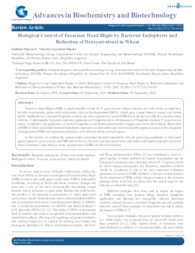Biological control of fusarium head blight by bacterial endophytes and reduction of deoxynivalenol in wheat.
Biological control of fusarium head blight by bacterial endophytes and reduction of deoxynivalenol in wheat.
Author(s): DEGRASSI, G.; CARPENTIERI-PIPOLO, V.
Summary: Fusarium Head Blight (FHB) is predominately caused by F. graminearum whose infection not only results in yield loss, but also contaminates grains with mycotoxins, such as deoxynivalenol (DON), which pose a great threat to human and animal health. Application of chemical fungicides remains the main approach to control FHB due to the lack of effective resistant wheat cultivars. Unfortunately, long-term intensive application of fungicides led to development of fungicide-resistant F. graminearum strains. In addition, the application of several fungicides at sub-lethal concentrations triggers mycotoxin biosynthesis. Biocontrol of FHB by wheat associated bacterial endophytes represents an alternative and more sustainable approach as part of the integrated management of FHB and mycotoxin production with reduced environmental impact. In this review, we explore the current wheat associated bacterial endophytes that are promising candidates as biocontrol agents against F. graminearum and FHB and we discuss the main mechanisms of action and major antifungal compounds produced which exhibited a high efficacy in the management of FHB and DON production.
Publication year: 2020
Types of publication: Journal article
Unit: Embrapa Wheat
Observation
Some of Embrapa's publications are published as ePub files. To read them, use or download one of the following free software options to your computer or mobile device. Android: Google Play Books; IOS: iBooks; Windows and Linux: Calibre.
Access other publications
Access the Agricultural Research Database (BDPA) to consult Embrapa's full library collection and records.
Visit Embrapa Bookstore to purchase books and other publications sold by Embrapa.

